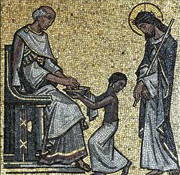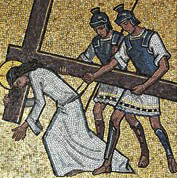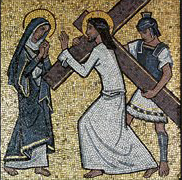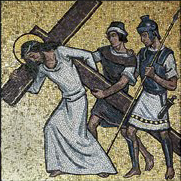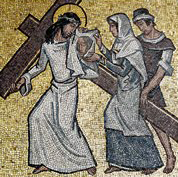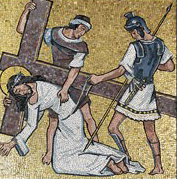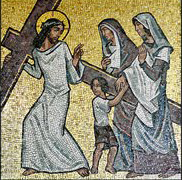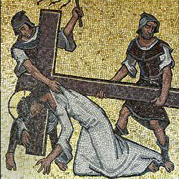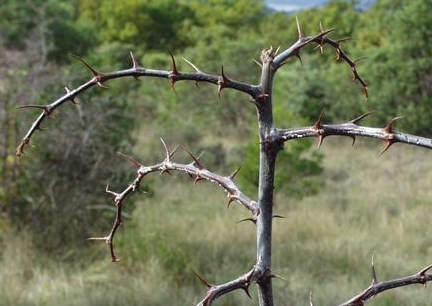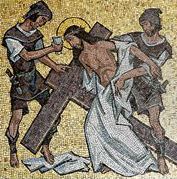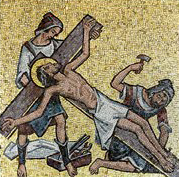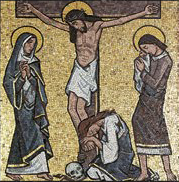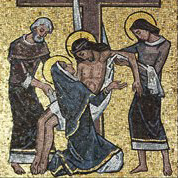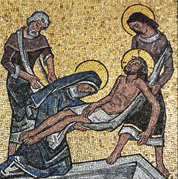MEETINGS!
Catechists

Representatives from our Parish Groups and Ministries




EASTER 2013
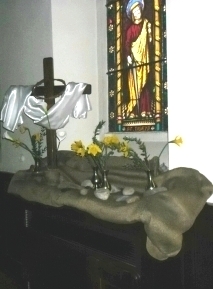

Easter Candle
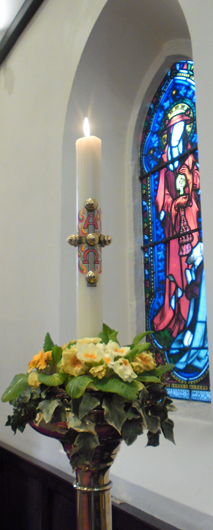
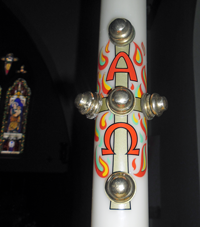

THE STATIONS OF THE CROSS Canon Brendan Hoban
THE FIRST STATION: JESUS IS CONDEMNED TO DEATH
The Roman governor of Judaea, Pontius Pilate, was based in Caesarea on the coast. He paid frequent visits to Jerusalem. The Roman army worshipped their standards, the famous eagles, as sacred, but the Romans had agreed to treat Jerusalem as a city dedicated to the God of the Jews - to our God. Under that agreement Roman troops in Jerusalem kept their standards covered.
On Pilate’s first visit to the city he told the troops with him not to cover their standards; he meant to show that he was boss. A deputation of leading Jews came to protest. When they refused to accept his ruling and go away, he ordered his troops to draw their swords. The Jews knelt and bared their necks for the blows, and Pilate realised that if he killed this lot there would be another lot along the next day. He gave way.
Amazingly, the Roman Empire in the time of Pilate had no civil service. To carry out his orders a Governor relied, firstly, on the slaves and freedmen who were members of his own household, then upon the Roman army, and finally and importantly, upon local authorities. If the leaders of the community refused their cooperation a governor could govern only with great difficulty.
And the local authority in Jerusalem, the Sanhedrin or Great Council of the Jews, wanted Jesus dead. Pilate tried to avoid passing sentence, but he gave way before the Council’s final threat: ‘If you let this man go free you are no friend to Caesar.’ In other words, let this man go free and we shall complain to the Emperor that you refused to execute a potential rebel. And was a Jewish carpenter worth risking his job, his fortune, and his reputation? So Pilate did what they wanted.
THE SECOND STATION: JESUS RECEIVES THE CROSS
Our pictures and the Stations on our church walls show Jesus’ cross as a neatly-planed piece of joinery. It is unlikely that the Romans went to the trouble. A couple of roughly-cut planks would do, or a single cross-beam which could be nailed to the trunk of a large tree. Jesus and the two thieves may just have carried these cross-beams.
As we know, it was too much for Jesus; the soldiers had to get help for him to carry his cross. He was clearly very weak.
THE THIRD STATION: JESUS FALLS THE FIRST TIME
We know Jesus stumbled because Simon of Cyrene was made to help him carry his cross. In the Middle Ages, as they do today, pilgrims followed the road that led from the Antonia fortress, where Pilate may well have been staying, to Calvary. In those days the road three times took an upward slope, and at these points pilgrims paused to remember the falls of Jesus. From this we have our three falls.
As we remember those falls, let us think of the people who were on the road that Jesus walked.
The first group were the soldiers charged with the execution. They were merely doing a job. They had mocked Jesus before they loaded him with the cross, but there was nothing personal in their attitude to him. Within the framework of what they were required to do there were even signs of kindness in them. They found help for Jesus on the road; when he was on the cross they gave him vinegar, presumably some of the mixture of wine vinegar and water that was known as posca, from their own rations; and as Jesus died the centurion in charge expressed admiration for him.
THE FOURTH STATION: JESUS MEETS HIS MOTHER
Throughout history mothers have seen their sons executed, in punishment for some real or imagined crime, or in the viciousness of civil war. We do not actually know from the Gospels that she was on the road to Calvary, but it would be surprising if she were not, for she was certainly at Calvary itself.
Once Jesus left home to become a wandering teacher Mary does not seem to have seen all that much of him. Jesus moved from Nazareth to Capharnaum. We have record of two occasions when Mary and other family members had tried to see Jesus, and things do not seem to have gone too well. Now he was being taken to die, and no one was stopping her seeing him; but there was hardly opportunity for intimate conversation. She looked, she wept, and she prayed.
THE FIFTH STATION: SIMON OF CYRENE HELPS TO CARRY THE CROSS OF JESUS
This incident tells us something about the state of Jesus. He simply could not carry his cross any further without assistance, and the soldiers grabbed hold of a man coming in from the country, and forced him to help. The man’s name was Simon of Cyrene.
Cyrene is in Libya; to this day one of the provinces of that country is Cyrenaica, named after Cyrene. Simon may have been a Libyan visitor or pilgrim to Jerusalem, or he may have come to live in the city. In his gospel St Mark tells us that Simon had two sons, Alexander and Rufus; St Mark seems to have assumed that the first readers of his gospel would know them. If, as seems very possible, St Mark wrote in Rome, then the brothers would have been members of the Christian community in that city, incredibly proud that their dad had helped Jesus to carry his cross.
THE SIXTH STATION: VERONICA
Veronica is a legendary character, who first appears in the Stations of the Cross a thousand years after the crucifixion. The story comes from her name: Vera, in Latin, means true, and icon means image in Greek. There are various veils round Europe, all claimed to be the genuine one.
But let the legendary Veronica stand for all the good and decent people who were horrified by what they saw in the narrow streets of Jerusalem that day, who knew that Jesus was the innocent victim of politicians, and would have done something to help if they had know how. Instead, they had to stand and stare.
THE SEVENTH STATION: THE SECOND FALL
Among those who witnessed the falls of Jesus were members of the Sanhedrin that had petitioned Pilate to put Jesus to death. Not all of them had voted for the execution; we know that Joseph of Arimathea did not, and there may well have been others. As they watched Jesus dragging his cross they must have thought of that they had done. The High Priest and the others had not become priests out of any sense of vocation; they had inherited their positions. (In 1990 a cave was found in the Jerusalem area containing jars of human bones. The names on the jars showed that this was the family tomb of the High Priest, Caiaphas.) But they were intelligent, educated, and shrewd, and they knew the Jewish faith. They knew they were condemning an innocent man. Why?
The Jews believed that God had made them a nation, and they therefore had the right to be independent of the Romans or anyone else. There were always those who wanted to assert this independence by violent revolution, and some Jews thought that God was bound to support them.
Others - and this included the Sanhedrin - were convinced that the Jews could not defeat the world’s biggest empire and its highly skilled professional army. If Jesus were to attract followers and start a rising against Rome this could bring untold suffering to the country, but not independence. So far Jesus had done nothing criminal; but for the safety of the country he should be removed before he got the chance to start a revolt. In the words of the High Priest, ‘It is better for one man to die than for a whole people to be destroyed.’
And so members of the Sanhedrin watched with satisfaction as Jesus was taken to execution. They felt they had done their patriotic duty.
THE EIGHTH STATION: THE WOMEN OF JERUSALEM WEEP FOR JESUS
Jesus died in or about the year 30AD. Thirty-six years later there took place the event that the Sanhedrin had crucified Jesus to avoid; the Jews rose in revolt against Rome. There was a great siege of Jerusalem. For a while it was broken off, while the Roman army fought a brief civil war to install its commander, Vespasian, as the new Roman Emperor. Then the troops came back under Vespasian’s son, Titus, to renew the siege, and finally to conquer the city in the year 70. Enormous numbers of people died in the fighting or from starvation during the siege. The Jewish men who survived were taken as prisoners to Rome, where they worked on building the Colosseum.
Jesus knew that the war would come, and what would be its outcome. This was not just because he had the gift of prophecy.
For Jesus, the Jews had a choice. They were both a religion and a nation. If they had put their religion first they would have recognised him, Jesus, as God’s messenger, and followed him. Instead, they were putting nationalism first, and this was bound to lead to rebellion against Rome. Jesus was not alone in realizing that rebellion would lead to disaster for the whole people. The Sanhedrin had realized it too, and this was why they were having Jesus put to death. They were simply wrong in what sort of person Jesus was; he was a Saviour, not a soldier.
This was why Jesus had himself wept over the city a few days before his passion. He knew what would come within a generation. Now he told the women not to weep for him, but for themselves and for their children. They would be old ladies, and their children fully mature, when the great disaster overwhelmed Jerusalem.
THE NINTH STATION: JESUS FALLS THE THIRD TIME
There is no reason to think that Jesus was anything other than a fit man for most of his life. He went round on foot teaching and preaching. He had presumably as balanced a diet as a peasant economy could provide. We are told by St Luke of rich ladies who ‘ministered to’ Jesus and his disciples.
We read, however, that he was too weak to carry his cross unaided. He died after just three hours on the cross, while the two thieves had to be finished off so that they would die before the festival. One possible reason is that he received a far more severe scourging than the thieves, but we have no evidence that this was the case. Was it perhaps the crown of thorns that weakened Jesus?
Botanists have given to one of the native thorn plants of Palestine the Latin name spina Christi, the thorn of Christ, and as a result people assume the crown must have been made from it. Its thorns are huge, but apparently the branches are too big and clumsy to be plaited into a crown.
Whichever kind of thorn was used, its piercing of Jesus’ head may been the reason for his stumbling on the way to Calvary. It may have increased his sufferings but shortened his life.
THE TENTH STATION: JESUS IS STRIPPED OF HIS GARMENTS
The Jerusalem of the time of Jesus was partly destroyed in the great revolt of 66-70AD, and another revolt against Rome fifty years later finished the job. The Romans rebuilt the city, and In the process moved it over a bit. The area called Golgotha, or Calvary, was outside the walls in the time of Jesus, but has been inside the walls since the Roman rebuilt them. Golgotha is covered today by the Church of the Holy Sepulchre, which contains the supposed sites of the crucifixion and of the burial of Jesus. The tomb is at a lower level than the crucifixion site. Some years ago Israeli archaeologists investigated the area, and their discoveries match up pretty well with the gospels.
They found that originally the site had been a hill, which for some centuries was used as a quarry for the building of Jerusalem. That stopped some time before the time of Jesus. Part of the hill remained standing, but much of it had been quarried away. The quarried part became a garden, where tombs were cut into the remaining rock. The site of the crucifixion is on top of the hill, and Jesus’ tomb was one of those cut into the rock at the lower level.
When a criminal was crucified the likely site was near a city gate, as a warning to others to behave themselves. If a site was raised it would be even more visible. Such was the top of the hill where Jesus died, known as the Place of the Skull - Golgotha in Aramaic and Calvaria in Latin. Here Jesus and the other two convicted men were brought for the ghastly business of crucifixion. Here they were stripped. Jesus had one luxury item of clothing, a long undergarment; the executioners raffled it between them.
THE ELEVENTH STATION: JESUS IS NAILED TO THE CROSS
The point of crucifixion was that it led to certain death, and was extremely painful. Roman citizens, a privileged class the Empire, were therefore spared crucifixion if they were condemned to death. In the early fourth century the newly-Christian Emperor Constantine forbade further crucifixions.
There is still argument about how the punishment achieved its effect. One possibility is that hanging on the cross narrowed the victim’s lungs, so that he found it ever harder to breathe. The one way he could relieve this was to force his weight down on the nails through his feet, which was incredibly painful. So he went up and down until he ran completely out of breath, and finally slumped down and died. This theory seems to be confirmed by the fact that breaking the legs of the crucified person, - which meant he could no longer hold himself upright, - was a way of finishing him off quickly.
Before he was nailed Jesus was offered a drink, wine mixed with myrrh, which may have lessened the pain but may have made it harder for someone being crucified to resist what was happening to him and perhaps eased the task of the executioners. Jesus refused it.
THE TWELFTH STATION: JESUS DIES ON THE CROSS
It seems to have taken Jesus about three hours to die on the cross. (Spartacus, the famous leader of a slave revolt, took a week to die.) Soldiers remained on duty to ensure that the crucified men were not rescued.
There was some to-ing and fro-ing between Golgotha and Pilate’s residence. The Jewish leaders asked that the sign ‘Jesus of Nazareth, King of the Jews’ be removed; Pilate refused. They later asked that the prisoners be finished off quickly by having their legs broken, so that they would not be alive on the feast of the Passover; Pilate agreed. At the cross were Mary, Jesus’ mother; some other women from the group of people who had followed Jesus; and the beloved disciple. We have record of Jesus speaking seven times. He spoke to the ‘good thief’, saying, ‘Indeed, I promise you, today you will be with me in paradise.’ He spoke to his mother and to St John, entrusting them to one another. He called out three times to his Father, the first time praying for his executioners: ‘Father, forgive them for they do not know what they are doing.’ There were the extraordinary words, ‘My God, my God, why have you forsaken me?’ It has been commented that never were emotions and reality further apart. He said, ‘Father, into your hands I commend my spirit.’ And finally he cried out, ‘It is finished’, and he died. We have record of the words of just one person at this point. They were spoken by, of all people, the Roman centurion in charge of the execution. According to the gospels of Matthew and Mark he said, ‘This man was a son of God’; according to Luke he said, ‘This was a great and a good man.’ In awe of what he had seen, he probably said slightly different things to different people.
Various officers of the Roman army are mentioned in the gospels and the Acts of the Apostles: a number of them were centurions, and one was the tribune in charge of the troops in Jerusalem on St Paul’s final visit there. All come across as honourable and trustworthy men. None was more surprising than this centurion, who in the horrors of a place of execution had his extraordinary insight into the one he had just killed and in killing had brought about the redemption of the world.
THE THIRTEENTH STATION: JESUS IS TAKEN DOWN FROM THE CROSS
Joseph of Arimathea, a follower of Jesus who was a member of the Sanhedrin, seems to have arrived at Golgotha after Jesus had died. He went immediately to Pilate to ask for permission to take down the body of Jesus and bury it. Pilate agreed. Joseph was joined by Nicodemus, a secret disciple of Jesus and a rich man, and they took on the horrible task of taking down the body from the cross.
Sculptors and painters have depicted Mary as she held in her arms the body of hr dead son. The image is known as a Pietá in Italian, as Our Lady of Pity in English.
THE FOURTEENTH STATION: THE BODY OF JESUS IS LAID IN A TOMB
Jesus died at about three o’clock in the afternoon, and the feast of the Passover began at six o’clock. Joseph and Nicodemus had to take down Jesus’ body, which must have taken some time, and to find somewhere to put it. They were not looking for a place to bury the body, but for somewhere to keep it from Friday evening until Sunday morning, when the Passover would be over and it might be possible to arrange a funeral.
Nicodemus, like many other rich men of his time, had already provided himself with a tomb. It had been cut into the rock wall of the garden below the place where Jesus had been crucified. Like many such tombs which survive, it was a cave with a number of niches in which bodies could be laid.
Here then, by themselves or with the assistance of their servants or of other friends of Jesus, they moved his body. The stone they rolled against the door would have been in the shape of a coin on edge, standing three or four feet high. It would have been leaning against the rock face, and could be rolled into a matching slot In front of the door of the tomb.
Leading Jews now went yet again to Pilate. Would he put Roman soldiers on guard at the tomb, so that the disciples could not come and steal the body and then announce that Jesus was risen from the dead? Pilate told them that they had their own guards, - presumably to keep order in the temple - and they could use them. They were not getting any Roman soldiers.
Joseph and Nicodemus men apparently did not feel obliged to tell the women where they were moving the body. They were desperately short of time.
But some of the women followed them as they carried the crumpled body of Jesus to Nicodemus’s tomb. They knew it was a temporary placement, and they resolved to come back on Sunday morning and anoint the body before it was finally buried.
Good Friday, March 29th, 2013St Winefride's, Neston |

